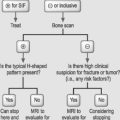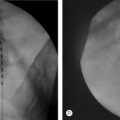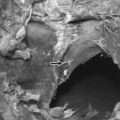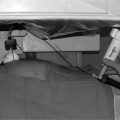CHAPTER 74 Thoracic Pain Syndromes
Thoracic pain accounts for approximately 5% of all referrals to the authors’ pain clinic in a University Hospital in the Netherlands,1 which is consistent with that of other clinics.2 Thoracic pain has a varied spectrum of possible etiologies including visceral pain from cardiac and lung pathology to pain from intra-abdominal organs (upper abdominal organs such as gall bladder and pancreas may be referred to the chest). In the lower thoracic regions pain must be differentiated from renal pathology.3 Pain from C5 may be referred over the anterior chest, while pain from C6, C7, and C8 may be referred to the scapular region.
Thoracic pain may have an underlying pathology such as disc herniations, aneurysms, tumors,5 postoperative sternal wound infection,6 trauma,7 old fractures, or herpetic infections,8 and stress fractures in athletes.9,10 Chronic postsurgical pain has been described following many different operations, most notably thoracotomy, mastectomy, and coronary artery bypass grafting (CABG) postsurgical pain syndromes.11–15
However, in most cases of thoracic pain there is no specific pathology identified as the cause of the pain and by default the pain is judged to be of spinal origin, emanating from nociceptive nerve endings in the periosteum, ligaments, discs, or joints.16
THORACIC MECHANICAL PAIN FEATURES
Clinical syndrome
Thoracic mechanical pain includes pain from both thoracic facet joints and thoracic discs.
Pain emanating from thoracic facet joints is usually related to degenerative processes, vertebral collapse, and continuous mechanical straining.16–18 The initial problem can be in the facet joint but may be elsewhere in the spine.19 As with lumbar and cervical facet syndromes there are no specific criteria which have been established whereby facet joint pain could be diagnosed based on patient’s history and/or physical examination. A diagnosis of thoracic facet joint syndrome can be made based on similarity of symptoms to lumbar and cervical facet syndromes.
In 1993, Stolker et al. defined ‘major’ and ‘minor’ criteria for the diagnosis of thoracic facet joint pain.18
Minor additional diagnostic criteria include:
Indications for radiofrequency procedures
These criteria were the basis for a study by Stolker et al. when they evaluated 40 patients who had a diagnosis of thoracic facet syndrome based on the above-mentioned criteria. These patients underwent percutaneous facet joint denervation (PFD). Included were 24 left sided, 21 right sided and 6 bilateral cases. Seven study patients underwent two sessions and two patients had three PFD sessions. Eighty-two percent of patients had 50–75% pain relief at 2 months. Four patients were lost to long-term follow-up (18–54 months; mean 31 months). Forty-four percent of study patients were pain free while 39% had a 50% or greater reduction in their pain.18 Interestingly, considering that these criteria were non-specific for thoracic facet syndrome, all patients in this study had positive diagnostic blocks performed prior to radiofrequency ablation. Stolker et al. attributed the results to the consistent course that the medial branch of the dorsal rami of the thoracic spinal nerves travel as they leave the intertransverse space; however, the anatomical target point (junction between the superior articular process and the transverse process) utilized in their study is at variance with the anatomical course of thoracic medial branch described by Chua and Bogduk.20
Chua and Bogduk reported that the medial branch crosses the superolateral corner of the transverse processes and then passes medially and inferiorly along the posterior surfaces of the transverse processes, before entering the multifidus muscle which it supplies.20 Chua and Bogduk have called for the need for a double-blind, controlled clinical trials of Stolker et al.’s approach to thoracic facet nerve denervation or modification of their procedure so as to be consistent with the surgical anatomy of the thoracic medial branches.20
In another study by Tzaan and Tasker in 2000 which evaluated 17 patients with thoracic facet syndrome, 15 patients had satisfactory pain relief at follow-up with 2 patients having their procedure repeated.21
Pevsner et al. evaluated radio frequency ablation in 122 patients with mechanical spinal pain at cervical (20%) and thoracolumbar (80%) levels. At 1-year follow-up 63% had good results (at least 50% decrease in pain levels) and 37% had no effect (<30 % reduction in their pain levels).22
Side effects and complications
Spinal thermocoagulation procedures are generally free from side effects other than local contusion and edema at the needle sites. The most common side effect was sensory loss and neuropathic pain in the distribution of the cutaneous branches of the posterior rami.21 Minor complications occurred in 27 patients (22%) who had transient discomfort and burning pain.22
THORACIC DISC LESIONS
Clinical syndrome
Thoracic disc lesions account for 0.5–2% of all disc lesions.23,24
Symptomatic disc disease is thought to be an uncommon problem with a prevalence of asymptomatic cases of 14.3%.25 Degenerative disc disease is more commonly found in the lower thoracic spine with the upper third (T1–2 to T4–5) being the least affected area.26,27 However, T1–2 is the most common level affected when the upper thoracic spine is involved.28
Recently, Arana et al., in a study of 156 patients with cervical disc pain, reported that 13.4% of these patients had degenerative changes in the upper thoracic spine, most notably at T2–3, with correlation between degenerative disc contour at the C7–T1 level and T1–2, T2–3, T3–4.29
Girard, in another study, evaluated temporal changes in thoracic disc in 40 patients with pain.29a Baseline presence of disc herniation was 10%, degenerative disease 14%, endplate marrow signal alteration 2.3%, Schmorl’s nodes 9.6%; follow-up was 4–149 weeks. Repeat scan revealed a new incidence of disc herniation of 1.5%, degenerative disc disease 2%, all findings predominated in the lower thoracic vertebrae T6–10. Herniations showed the most ability to modify over time with just over one-quarter (27%) showing change. Schmorl nodes showed the least change over time.29
While the majority of prediction indicator studies have been done on lumbar spine, one can infer that a similar clinical picture holds for the thoracic spine. A tissue can only generate pain if it is innervated. In a normal human lumbar disc, nerve endings can only be found in the periphery of the outer anulus at a depth of a few millimeters.30 In highly degenerated discs nerves may even penetrate into the nucleus pulposus.31 Most of these nerve fibers, which are identified by immunohistochemistry, accompany blood vessels relating probably to vasoregulation. Another set of neural fibers has been found in the nucleus of painful discs of those undergoing anterior fusion surgery for low back pain. These neural structures express substance P and have a morphology of nociceptive nerve terminals. These findings emphasize the role of nerve terminals of the degenerated disc in the pathology of back pain and make the distinction between painful disc disease and nonpainful disc disease degeneration more plausible.
Discography has been regarded as the gold standard in the diagnosis of discogenic pain. Discographic studies have shown that only annular ruptures extending to the outer anulus reproduce exact or similar pain to that previously described by the patient.32 Discography has been widely used to study and compare to magnetic resonance imaging (MRI) findings of patients with discogenic pain. In addition to annular ruptures, potential discogenic signs on MRI include high intensity zones (HIZs) lesions and endplate degeneration known as modic changes.33 HIZ lesions are not as useful in predicting which individuals will have discogenic pain34 compared with modic changes which are a more reliable imaging predictor of discogenic pain.35 Thoracic discography has been utilized by Schellhas et al. in a study of 100 patients with clinical pain and MRI imaging with morphologically abnormal thoracic disc(s). Abnormal thoracic discs on MRI and at least one control disc adjacent to the abnormal discs were injected with nonionic contrast or normal saline, X-rays were obtained, and pain was rated in intensity from 0 to 10. Discs with annular tears were found to be painful approximately 75% of the time (with a clinical concordance of 50%). Control discs were invariably painless. Schellhas et al. concluded that thoracic discography can be performed safely as a tertiary diagnostic procedure to determine if degenerated discs on MRI studies are related to clinical complaints.36 In another study, the Wood et al. evaluated 10 healthy volunteers using MRI and four-level discography. Provocative responses were graded from 0 to 10. The mean pain response was 2.4/10; however, three discs were intensely painful, on MRI 27 discs of 40 were abnormal with endplate abnormalities, annular tears, and/or herniations. In parallel, they evaluated 10 adults, without pending litigation who had thoracic pain; the mean pain response was 6.3/10 on discography. Twenty-four discs were concordantly painful of the 48 discs studied, and MRI revealed that 21 discs were normal; however, on discography only 10 were judged as normal. Schellhas et al. concluded that thoracic discs with prominent Schmorl’s nodes may be intensely painful even in lifelong asymptomatic individuals but the pain is concordant.37
Thoracic intradiscal pressure has been evaluated as an aid in to understanding the biomechanics of thoracic spine.38 Although discography is the gold standard in the diagnosis of discogenic pain, it is an invasive procedure and not employed for routine diagnosis. Unfortunately, in the chronic low back pain patient population no clinical discriminator has been found that can differentiate discogenic from nondiscogenic back pain.39 The bony vibration test, whereby a small hand-held vibrator is used to produce pain provocation, similar to that in discography, has been tried as a noninvasive pain provocation method to be used in combination with MRI in identifying symptomatic disc pathology.40
Genetic variations in collagen IX and aggrecan have been held accountable for lumbar disc disease, it is highly probable that similar variations will be accountable for thoracic disc disease.41
Indications for therapies in discogenic pain
Treatment programs for discogenic pain include stabilization of the symptomatic motion segments in order to eliminate painful motion,42 but the external validity of spinal fixation is now being compared with conservative care. The results of randomized, controlled trials do not unequivocally support the use of spinal stabilization procedures.43,44 Video-assisted thorascopic (VAT) surgery has been reported to be successful in thoracic disc herniations. Anand and Regan evaluated 100 patients with a minimum of 2 years’ follow-up after VATs for thoracic disc herniation. They reported an overall 84% satisfaction rate with long-term clinical success rate of 70% in this study population.45 The role of intradiscal electrothermal therapy (IDET) has an exciting prospect as future therapy for the management of discogenic pain as an alternative to spinal fusion in selected patients. To date, IDET has been only described in the management of lumbar disc pain. This may prove especially useful for the young patient with preserved disc height and patients with inoperable multilevel disease.46 However, its effects have been described predominantly in lumbar disc pain to date.47 The long-term benefits of IDET therapy still have to undergo the rigorous of clinical trials,48 but for the present its role is as an antecedent rather than alternative to spinal fusion.
Side effects and complications
Spinal stabilization procedures are associated with the usual postoperative complications including blood loss and infection. Neurological complication secondary to vascular compromise is fortunately very rare.49
Outcomes
For the present, surgical stabilization procedures and conservative management programs form the mainstay of therapy in treating thoracic discogenic pain. The role of IDET is for the present restricted to lumbar disc pain. However, IDET seems a promising therapy, but scientific data regarding the pathophysiology, biologic effects, and clinical results are relatively scarce. Early biomechanical and histological investigations into the effects of IDET are conflicting. However, in early prospective human trials, IDET seems to provide some benefit with low risk. IDET is a potentially beneficial treatment for internal disc disruption in carefully selected patients as an alternative to spinal fusion. More basic science and clinical research with long-term follow-up evaluation is necessary.48 Emerging therapies with monoclonal antibodies are only at a conceptual stage and it will be many years before they are adopted as meaningful therapeutic options in the management of discogenic pain.
THORACIC SEGMENTAL PAIN SYNDROMES
Clinical syndrome
Thoracic segmental pain syndromes have many etiologies including disease and/or lesions of ribs, disorders of the thoracic skeletal spine (fractures, arthritis, metabolic disorders, and tumors), or neuropathies originating from spinal roots, spinal nerves, or intercostal nerves.16 Some thoracic segmental pain syndromes are iatrogenic postsurgery, such as post-thoracotomy and postmastectomy syndromes and scar tissue pain after upper gastrointestinal surgery.12–15 Percutaneous thoracic sympathectomy is considered the most efficacious for sympathetic mediated pain, Raynaud’s syndrome, hyperhidrosis, and vasculopathy.50 Percutaneous radiofrequency adjacent to the thoracic dorsal root ganglion (DRG) has been described for segmental nerve pain related to intercostal pain, rib tip syndrome, twelfth rib syndrome, vertebral collapse, and segmental peripheral neuralgia.
Indications for percutaneous radiofrequency lesioning
Stolker et al.51 evaluated 45 patients with thoracic segmental pain who fulfilled the following criteria:
Clinical diagnoses included intercostal neuralgia, post-thoracotomy pain syndrome, postmastectomy pain syndrome, twelfth rib syndrome, rib resection, osteoporosis, vertebral metastasis, and traumatic collapsed vertebra. The 45 patients participating in this study underwent 53 percutaneous radiofrequency procedures adjacent to the dorsal root ganglion, 37 at one level, one patient bilaterally at one level, and seven patients at two levels unilaterally. At first evaluation (using a five-grade evaluation scale) 2 months postprocedure, 66.7% were pain free, 24% obtained more than 50% pain relief, and 9% obtained no pain relief. Four patients were lost to long-term follow up (died from their malignant disease). After a follow-up of 13–46 months (median 24 months) 49% were pain free, 37% had good pain relief, and 14.6% had no pain relief.51
In a similar study, van Kleef et al.1 evaluated effects of a single-level radiofrequency lesioning adjacent to the dorsal root ganglion in thoracic segmental pain. In this study, 43 patients were evaluated with a minimum of 6 months’ history of unilateral thoracic segmental pain unresponsive to conservative therapies. Twenty-seven of the patients had pain in the distribution of one or two segments (group I) only, while 16 patients had pain in more than two segmental levels (group II). Short-term analysis at 8 weeks postprocedure showed patients in group I were pain free or had good pain relief in 52% of patients, while only 18% of patients in group II were pain free or had good pain relief. Long-term follow-up (36–168 weeks; mean 99 weeks) demonstrated freedom from pain or good pain relief in 37% of patients in group I while only 18% of patients in group II at long-term follow-up (40–160 weeks; mean 128 weeks) were pain free or had good pain relief.
Side effect and complications
In the study by Stolker et al., 13% of patients suffered a transient burning pain that subsided within 3 weeks. Four percent of patients suffered a slight sensory loss in the corresponding dermatome, the sensory loss resolved in 3 months. There was no motor loss and no incidence of pneumothorax.51 In the study by Van Kleef et al., a similar side effect profile was noted with 16% suffering a slight burning pain in the treated dermatome; in addition, 16% of patients had slight hypoesthesia in the treated dermatome at initial follow-up. These side effects had resolved by 12 weeks postprocedure. There was no dysthesias or pneumothorax.1
It is interesting to note in both studies that dorsal root ganglion lesioning above T7 was performed via a hole drilled in the lamina. This was done because the angle of the ribs prevent accurate passage of a needle. A more lateral approach could have been employed in these studies to approach the foramen but, due to the proximity of the pleura, there was a substantial risk of pneumothorax and neither group of authors felt such a technique was justifiable. Complications can occur. Ischemic spinal cord lesions have been reported previously,52 which describe percutaneous radiofrequency lesioning provoking an ischemic lesion on the opposite side to where the lesion was made and one segment lower in two patients. The authors postulated that the lesion was secondary to a ‘steal’ of the local circulation due to the percutaneous radiofrequency spinal lesioning. However, both of these complications were in elderly patients with cardiorespiratory and general vascular disease. Even though radiofrequency is advocated in elderly patients, they are at a higher risk of complication than in the healthy population. When performing radiofrequency procedures, one must be mindful of the blood supply in the thoracic region of the spinal cord. The upper and lower areas are well supplied, but the midthoracic region (T5–8) has poor circulation; the arteries are smaller and less numerous, leaving this region more vulnerable to ischemic lesions.53
1 van Kleef M, Barendse GA, Dingemans WA, et al. Effects of producing a radiofrequency lesion adjacent to the dorsal root ganglion in patients with thoracic segmental pain. Clin J Pain. 1995;11:325-332.
2 Manchikanti L. Facet joint pain and the role of neural blockade in its management. Curr Rev Pain. 1999;3:348-358.
3 Quast MS, Goldglies ML. A new differential diagnosis for musculoskeletal posterior thoracic wall pain. A case report. Orthop Rev. 1989;18:461-465.
4 Barendse GA, van Den Berg SG, Kessels AH, et al. Randomized controlled trial of percutaneous intradiscal radiofrequency thermocoagulation for chronic discogenic back pain: lack of effect from a 90-second 70 C lesion. Spine. 2001;26:287-292.
5 Berger A, Henry L, Goldberg M. Surgical palliation of thoracic malignancies. Surg Oncol Clin N Am. 2004;13:429-453.
6 Verillo SC. Negative pressure therapy for infected sternal wounds. J WOCN. 2004;31:72-74.
7 Wanek S, Mayberry JC. Blunt thoracic trauma: flail chest, pulmonary contusion, and blast injury. Crit Care Clin. 2004;20:71-81.
8 Kost RG, Straus SE. Postherpetic neuralgia – pathogenesis, treatment, and prevention. N Engl J Med. 1996;335:32-42.
9 Karlson KA. Thoracic region pain in athletes. Curr Sports Med Rep. 2004;3:53-57.
10 Davis BA, Finnoff JT. Diagnosis and management of thoracic and rib pain in rowers. Curr Sports Med Rep. 2003;2:281-287.
11 Kalso E, Perttunen K, Kaasinen S. Pain after thoracic surgery. Acta Anaesthesiol Scand. 1992;36:96-100.
12 Smith WC, Bourne D, Squair J, et al. A retrospective cohort study of post mastectomy pain syndrome. Pain. 1999;83:91-95.
13 Mailis A, Chan J, Basinski A, et al. Chest wall pain after aortocoronary bypass surgery using internal mammary artery graft: a new pain syndrome? Heart Lung. 1989;18:553-558.
14 Bruce J, Drury N, Poobalan AS, et al. The prevalence of chronic chest and leg pain following cardiac surgery: a historical cohort study. Pain. 2003;104:265-273.
15 Kalso E, Mennander S, Tasmuth T, et al. Chronic post-sternotomy pain. Acta Anaesthesiol Scand. 2001;45:935-939.
16 Bonica JJ, Sola AF. Chest pain caused by other disorders. In: Bonica JJ, editor. The management of pain. Philadelphia: Lea & Febiger; 1991:1144-1145.
17 Merskey H, Bogduk N. Classification of chronic pain: descriptions of chronic pain syndromes and definitions of pain terms, 2nd edn. Seattle, WA: IASP Press, 1994.
18 Stolker RJ, Vervest AC, Groen GJ. Percutaneous facet denervation in chronic thoracic spinal pain. Acta Neurochir (Wien). 1993;122:82-90.
19 Bogduk N, Marsland A. The cervical zygapophyseal joints as a source of neck pain. Spine. 1988;13:610-617.
20 Chua WH, Bogduk N. The surgical anatomy of thoracic facet denervation. Acta Neurochir (Wien). 1995;136:140-144.
21 Tzaan WC, Tasker RR. Percutaneous radiofrequency facet rhizotomy – experience with 118 procedures and reappraisal of its value. Can J Neurol Sci. 2000;27:125-130.
22 Pevsner Y, Shabat S, Catz A, et al. The role of radiofrequency in the treatment of mechanical pain of spinal origin. Eur Spine J. 2003;12:602-605.
23 Krämer J. Intervertebral disc disease: Causes, diagnosis, treatment, and prophylaxis, 2nd edn. Stuttgart: Georg Thieme-Verlag, 1990.
24 Vallo MB, Ranshoff RJ. Thoracic disc disease, 2nd edn., Philadelphia: WB Saunders; 1982:500.
25 Matsumoto M, Fujimura Y, Suzuki N, et al. MRI of cervical intervertebral discs in asymptomatic subjects. J Bone Joint Surg [Br]. 1998;80:19-24.
26 Morgan H, Abood C. Disc herniation at T1–2. Report of four cases and literature review. J Neurosurg. 1998;88:148-150.
27 Awwad EE, Martin DS, Smith KRJr, et al. Asymptomatic versus symptomatic herniated thoracic discs: their frequency and characteristics as detected by computed tomography after myelography. Neurosurgery. 1991;28:180-186.
28 Boutin RD, Steinbach LS, Finnesey K. MR imaging of degenerative diseases in the cervical spine. Magn Reson Imaging Clin N Am. 2000;8:471-490.
29 Arana E, Marti-Bonmati L, Molla E, et al. Upper thoracic-spine disc degeneration in patients with cervical pain. Skeletal Radiol. 2004;33:29-33.
29a Girard CJ, Schweitzer ME, Morrison WB. Thoracic spine disc-related abnormalities: longitudinal MR imaging assessment. Skeletal Radiol. 2004;33(4):216-222.
30 Ashton IK, Roberts S, Jaffray DC, et al. Neuropeptides in the human intervertebral disc. J Orthop Res. 1994;12:186-192.
31 Freemont AJ, Peacock TE, Goupille P, et al. Nerve ingrowth into diseased intervertebral disc in chronic back pain. Lancet. 1997;350:178-181.
32 Moneta GB, Videman T, Kaivanto K, et al. Reported pain during lumbar discography as a function of annular ruptures and disc degeneration. A re-analysis of 833 discograms. Spine. 1994;19:1968-1974.
33 Modic MT, Masaryk TJ, Ross JS, et al. Imaging of degenerative disk disease. Radiology. 1988;168:177-186.
34 Carragee EJ, Paragioudakis SJ, Khurana S. 2000 Volvo Award winner in clinical studies: Lumbar high-intensity zone and discography in subjects without low back problems. Spine. 2000;25:2987-2992.
35 Braithwaite I, White J, Saifuddin A, et al. Vertebral end-plate (Modic) changes on lumbar spine MRI: correlation with pain reproduction at lumbar discography. Eur Spine. 1998;7:363-368.
36 Schellhas KP, Pollei SR, Dorwart RH. Thoracic discography. A safe and reliable technique. Spine. 1994;19:2103-2109.
37 Wood KB, Schellhas KP, Garvey TA, et al. Thoracic discography in healthy individuals. A controlled prospective study of magnetic resonance imaging and discography in asymptomatic and symptomatic individuals. Spine. 1999;24:1548-1555.
38 Polga DJ, Beaubien BP, Kallemeier PM, et al. Measurement of in vivo intradiscal pressure in healthy thoracic intervertebral discs. Spine. 2004;29:1320-1324.
39 Schwarzer AC, Wang SC, O’Driscoll D, et al. The ability of computed tomography to identify a painful zygapophyseal joint in patients with chronic low back pain. Spine. 1995;20:907-912.
40 Yrjama M, Tervonen O, Kurunlahti M, et al. Bony vibration stimulation test combined with magnetic resonance imaging. Can discography be replaced? Spine. 1997;22:808-813.
41 Ala-Kokko L. Genetic risk factors for lumbar disc disease. Ann Med. 2002;34:42-47.
42 Frymoyer JW, Ducker TB, Hadler NM, et al. The adult spine. Principles and practice. Philadelphia, PA: Lippincott, 1997.
43 Fairbank AJ, Frost H, Wilson MacDonald J, et al., The Spine Stabilisation Group. The MRC spine stabilisation trial. A randomized controlled trial to compare surgical stabilisation of the lumbar spine versus an intensive rehabilitation programme on outcome in patients with chronic low back pain. Abstract in the ISSLS meeting, 2004, Porto, Portugal.
44 Fritzell P, Hägg O, Nordwall A, The Swedish Lumbar Spine Study Group. 5–10 years follow up in the Swedish lumbar spine study. Abstract in the ISSLS meeting, 2004, Porto, Portugal.
45 Anand N, Regan JJ. Video-assisted thoracoscopic surgery for thoracic disc disease: Classification and outcome study of 100 consecutive cases with a 2-year minimum follow-up period. Spine. 2002;27:871-879.
46 Saal JA, Saal JS. Intradiscal electrothermal therapy for the treatment of chronic discogenic low back pain. Clin Sports Med. 2002;21:167-187.
47 Pauza KJ, Howell S, Dreyfuss P, et al. A randomized, placebo-controlled trial of intradiscal electrothermal therapy for the treatment of discogenic low back pain. Spine J. 2004;4:27-35.
48 Biyani A, Andersson GB, Chaudhary H, et al. Intradiscal electrothermal therapy: a treatment option in patients with internal disc disruption. Spine. 2003;28:S8-S14.
49 Fessler RG, Sturgill M. Complications of surgery for thoracic disc disease [review]. Surg Neurol. 1998;49:609-618.
50 Wenger CC. Radiofrequency lesions for the treatment of spinal pain. Pain Digest. 1998;8:1-16.
51 Stolker RJ, Vervest AC, Groen GJ. The treatment of chronic thoracic segmental pain by radiofrequency percutaneous partial rhizotomy. J Neurosurg. 1994;80:986-992.
52 Koning HM, Koster HG, Niemeijer RP. Ischaemic spinal cord lesion following percutaneous radiofrequency spinal rhizotomy. Pain. 1991;45:161-166.
53 Lazorthes G. La vascularisation de la moelle épinière. Rev Neurol. 1962;6:535-557.







